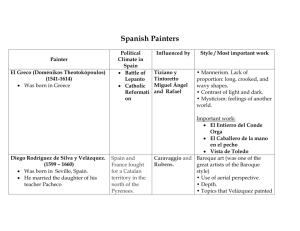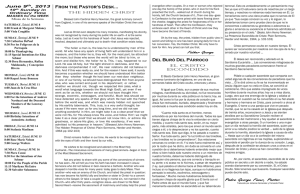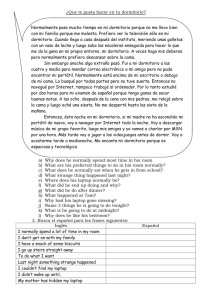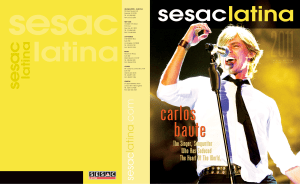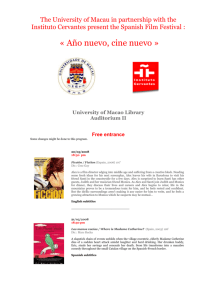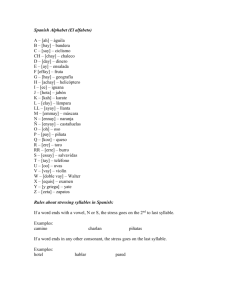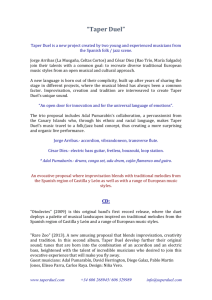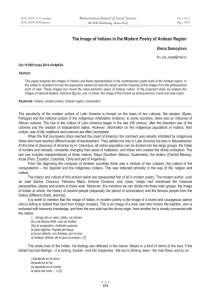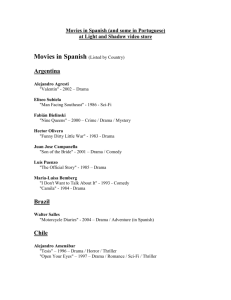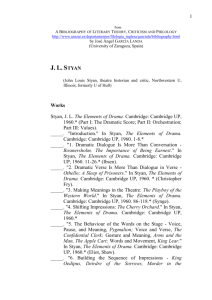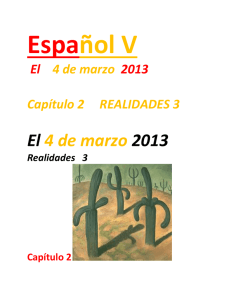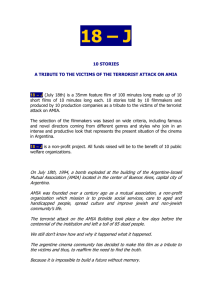“El objetivo de este curso es familiarizarnos con el teatro español
advertisement
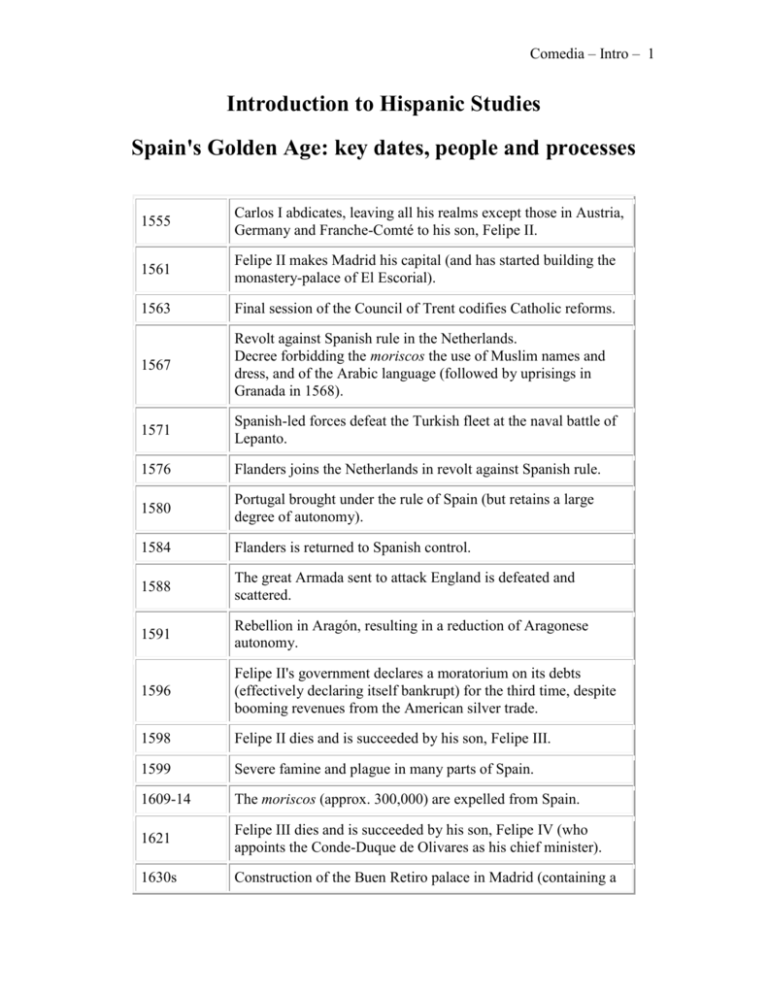
Comedia – Intro – 1 Introduction to Hispanic Studies Spain's Golden Age: key dates, people and processes 1555 Carlos I abdicates, leaving all his realms except those in Austria, Germany and Franche-Comté to his son, Felipe II. 1561 Felipe II makes Madrid his capital (and has started building the monastery-palace of El Escorial). 1563 Final session of the Council of Trent codifies Catholic reforms. 1567 Revolt against Spanish rule in the Netherlands. Decree forbidding the moriscos the use of Muslim names and dress, and of the Arabic language (followed by uprisings in Granada in 1568). 1571 Spanish-led forces defeat the Turkish fleet at the naval battle of Lepanto. 1576 Flanders joins the Netherlands in revolt against Spanish rule. 1580 Portugal brought under the rule of Spain (but retains a large degree of autonomy). 1584 Flanders is returned to Spanish control. 1588 The great Armada sent to attack England is defeated and scattered. 1591 Rebellion in Aragón, resulting in a reduction of Aragonese autonomy. 1596 Felipe II's government declares a moratorium on its debts (effectively declaring itself bankrupt) for the third time, despite booming revenues from the American silver trade. 1598 Felipe II dies and is succeeded by his son, Felipe III. 1599 Severe famine and plague in many parts of Spain. 1609-14 The moriscos (approx. 300,000) are expelled from Spain. 1621 Felipe III dies and is succeeded by his son, Felipe IV (who appoints the Conde-Duque de Olivares as his chief minister). 1630s Construction of the Buen Retiro palace in Madrid (containing a Comedia – Intro – 2 theatre). 1640 Revolts in Portugal (leading to Portuguese independence) and Catalunya. 1665 Felipe IV dies and is succeeded by his son, Carlos II. Writers Painters Cities Garcilaso de la Vega (1501-1536) Sonnets, elegies and three long Eclogues. Santa Teresa de Ávila (or de Jesús) (1515-82) Religious prose and poetry, and an autobiography (Vida). San Juan de la Cruz (1542-91) Mystical poetry. Miguel de Cervantes Saavedra (1547-1616) First part of Don Quixote published in 1605, second part in 1615; also Novelas ejemplares, poetry and plays. Luis de Góngora y Argote (1561-1627) Sonnets, ballads and two long poems: Soledades and La fábula de Polifemo y Galatea. Lope de Vega Carpio (1562-1635) Hundreds of plays, including Peribáñez (c.1606), Fuenteovejuna (c.1612), El caballero de Olmedo (c.1620); also poetry and novels. Francisco de Quevedo y Villegas (1580-1645) Picaresque novel Historia de la vida del Buscón (published in 1626); a great deal of poetry; and political and satirical books and pamphlets. Tirso de Molina (pseudonym of Fray Gabriel Téllez) (1583-1648) Plays, especially religious, including El condenado por desconfiado (c.1624) and El burlador de Sevilla (1630); also collections of stories. Pedro Calderón de la Barca (1600-81) Plays include La vida es sueño (1635), El médico de su honra (c.1635), El alcalde de Zalamea (c.1643); also autos sacramentales (religious allegories). El Greco (Domenicos Theotocopoulos) 1541-1614. Francisco Zurbarán 1598-1664. Diego Velázquez de Silva 1599-1660. Bartolomé Esteban Murillo 1617-82. Madrid - the political capital from 1561, centred on the court; population and prosperity growing in late 16th and early 17th centuries; strong influence of a Sevillian elite Comedia – Intro – 3 Key social, political and economic processes in the early 17th century (political and cultural) around Olivares from 1621. Sevilla - the economic capital, one of the largest cities in Europe in 1600; American trade at its peak around 1600, but largely under foreign control and in decline by 1640; lavish displays of wealth (including artistic patronage) alongside extreme poverty. Toledo - the spiritual capital and centre of the Church; losing population and prosperity in the 1580s-1640s, but painting flourished around El Greco 1577-1614. Tension between central (royal) power and local autonomy (within Spain and beyond); declining military and diplomatic effectiveness, competition from the Dutch and English; insufficient population and economic strength in Spain to sustain imperial commitments; lack of control over revenue and trade generated in the Americas; inflation, monetary debasement and an adverse trade balance; population reduced by epidemics, grain shortages, emigration and wars overseas; political influence, land ownership and social values dominated by Church and aristocracy; pressure for religious reform resisted by a powerful Church hierarchy. SPANISH DRAMA OF THE GOLDEN AGE The Spanish "Siglo De Oro" is the period of Spanish literature extending from the early 16th century to the late 17th century, generally considered the high point in Spain's literary history. The Golden Age began with the partial political unification of Spain about 1500. DRAMA The drama achieved its true splendour in the genius of Lope de Vega (in full, Lope Félix de Vega Carpio). Its manifesto was Lope's own treatise, Arte nuevo de hacer comedias en este tiempo (1609; “New Art of Writing Plays at This Time”), which rejected the Neoclassical “rules,” opted for a blend of comedy and tragedy and metrical variety, and made public opinion the arbiter of good taste. The new comedia (“drama”) was a “social” drama, ringing changes on the triple foundation of society: respect for crown, church, and the human personality, the last symbolized in the “point of honour” that Lope commended as the best theme of all. This was a matter of convention, “honour” being equivalent more or less to reputation. It was a drama less of character than of action Comedia – Intro – 4 and intrigue, which rarely grasped the essence of tragedy. What the great Spanish playwrights did possess was a remarkable sense of stagecraft and the ability to make the most intricate plot gripping. Lope, who claimed authorship of more than 1,800 comedias, towered over his contemporaries. He had an unerring sense of what could move an audience to respond to a reflection on the stage of some of the ingredients of its country's greatness. Through Lope the drama became “national” in the truest sense. The two main categories of his work are the native historical and the capa y espada (“cloak-and-sword”) plays of contemporary manners. Lope ransacked the literary past for heroic themes, chosen to illustrate aspects of the national character or of that social solidarity on which Spain rested. Más sobre la Comedia: La Comedia es ecléctica de principio a fin en estructura y contenido. Tan variada como la vida, compila todos los géneros dramáticos, desde la tragedia a la farsa, por lo general en la misma pieza. Difícilmente adopta una forma totalmente trágica o cómica. Sus elementos son múltiples. Lo serio se alterna con lo cómico, la sátira con la enseñanza moral, la historia y la leyenda con incidentes de la vida diaria o de la fantasía. Tal drama maneja con naturalidad las unidades de tiempo, lugar y acción. El tiempo empleado es variable y arbitrario. La acción puede ocurrir en más de un lugar dentro de un solo acto y pasar de un país o continente a otro entre actos. El género es caracterizado por una libertad absoluta, una variedad infinita de estilos y situaciones. Su única limitación reside en la extensión obligatoria de tres actos y del uso casi exclusivo del verso como vehículo de expresión. Se halla en la comedia, una división de tres partes: -El primer acto proporciona el argumento. -El segundo acto, los eventos se complican con mayor intensidad. -El tercer acto provee el desarrollo final de los eventos y la “solución” de los problemas. Usualmente se describe lo anterior de acuerdo al siguiente esquema: Orden → Desorden → Orden Lo cierto es, sin embargo, que en la Comedia el orden suele ser bastante frágil. En realidad se podría describir el proceso de este drama de esta otra manera: Desorden → Desorden agudizado → Desorden contenido Los personajes se dividen de acuerdo a la ordinaria escala social del antiguo régimen: reyes y princesas, damas y caballeros, campesinos y sirvientes. Frecuentemente aparecen el galán y la dama de clase alta, a menudo unidos en alguna trama de tipo amoroso. El gracioso, quien generalmente es el sirviente del galán, suele acompañar la acción. Este Comedia – Intro – 5 último personaje adquiere gran importancia: es a la vez fuente de deshogo cómico y espejo deformado de las ambiciones y valores de sus superiores sociales. Esta última característica lo convierte frecuentemente en fuente de diversas críticas de variado tipo. Se puede clasificar la Comedia de acuerd a la siguiente categorización: -Comedia histórica, heroica o de leyendas: Basada en hechos o crónicas históricas, leyendas clásicas o nacionales y sagas de héroes españoles o clásicos. -Comedia de capa y espada: Trata fundamentalmente de líos amorosos en ambientes urbanos. Sus personaje forjan su identidad cubiertos por su capa y ofendiendo defendiéndose con la espada. -Comedia de palacio: Trata de asuntos de intriga amorosa y política en ambientes de palacio, es decir, en el contexto social de reyes, príncipes, etc. -Comedia religiosa o de santos: Trata de temas religiosamente edificantes como las vidas de santos, mártires, etc. -Comedia moral o de carácter: Trata de la representación de algún vicio social o de algún defecto personal. Lope's immediate successors was Tirso de Molina (pseudonym of Gabriel Téllez), whose Burlador de Sevilla (1630; “The Trickster of Seville”) presented the Don Juan legend on stage for the first time. La prudencia en la mujer (1634; “Prudence in Woman”) figured among the greatest of Spanish historical dramas, as did El condenado por desconfiado (1635; The Doubter Damned) among the theological, while Tirso's cloak-and-sword comedies were among the liveliest of the type. Mexican-born Juan Ruiz de Alarcón y Mendoza struck a distinctive note. His 20 plays were sober, studied, and imbued with serious moral purpose, and his Verdad sospechosa (1634; “The Truth Suspected”) inspired the great French dramatist Pierre Corneille's Menteur. Corneille's famous Le Cid similarly had its source in the conflict between love and honour posed in Las mocedades del Cid (“The Youthful Exploits of the Cid”) by Guillén de Castro y Bellvís. Pedro Calderón de la Barca adapted Lope de Vega's formula for producing a tightly structured drama in which formal artistry and poetic texture are closely wedded to depth of theme and unity of dramatic purpose. One of the world's outstanding dramatists, Calderón wrote plays that were as effective in the public playhouses as in the newly built court theatre of Buen Retiro. The elaborate stage techniques of the latter enabled Calderón to excel in mythological drama (La estatua de Prometeo [1669; “The Statue of Prometheus”]) and contribute to the rise of a type of musical comedy known as the zarzuela (El jardín de Falerina [1648; “The Garden of Falerina”]). Calderón was a fertile creator, and his numerous secular plays encompassed both comedy and tragedy. In his best comedies, the conventions of intrigue and suspense are modified to create a subtle critique of urban mores and generally accepted values, astride the joy of laughter and the foreboding of eventual tragedy (La dama duende [1629; The Phantom Lady]). His Comedia – Intro – 6 tragedies probe deeply into the human predicament, exploring problems of personal and collective guilt (Las tres justicias en una [c. 1637; Three Judgments at a Blow]), the bathos of limited vision and lack of communication (El pintor de su deshonra [c. 1645; The Painter of His Own Dishonour]), the destructiveness of certain social codes (El médico de su honra [1635; The Surgeon of His Honour]), and the clash between the constructive nature of reason and the destructive violence of self-centred passion (La hija del aire [1653; “The Daughter of the Air”]). Some of his best known plays are more appropriately classified as high drama, offering a positive though never simplistic vision. El alcalde de Zalamea (c. 1640; The Mayor of Zalamea), for example, rejects the supremacy of social honour and points to the inner nature of man's true worth and dignity. Philosophical problems of determinism and free will are vividly dramatized in La vida es sueño (1635; Life Is a Dream ), in which the escape route from the confusion of life is shown to lie in an awareness of reality and self-knowledge. GENERAL INTEREST SITE: TEATRO DE LOS SIGLOS DE ORO http://www.spanish-books.net/literature/tesiglor.htm MORE SERIOUS SITES: Teatro clásico español http://www.uqtr.uquebec.ca/dlmo/TEATRO/teatro.html ASSOCIATION FOR HISPANIC CLASSICAL THEATER, INC. http://www.comedias.org/ VISUAL AIDS: EL CORRAL DEL PRÍNCIPE - (1583-1744) [A XVI AND XVII CENTURY SPANISH PLAYHOUSE] El antiguo Corral del Príncipe estaba situado en la actual Plaza de Santa Ana de Madrid, exactamente en el lugar donde hoy se levanta el Teatro Español . http://aix1.uottawa.ca/%7Ejmruano/Corral.html ARS THEATRICA - DOCUMENTACIÓN VISUAL http://parnaseo.uv.es/Ars/Doc_visual.html
